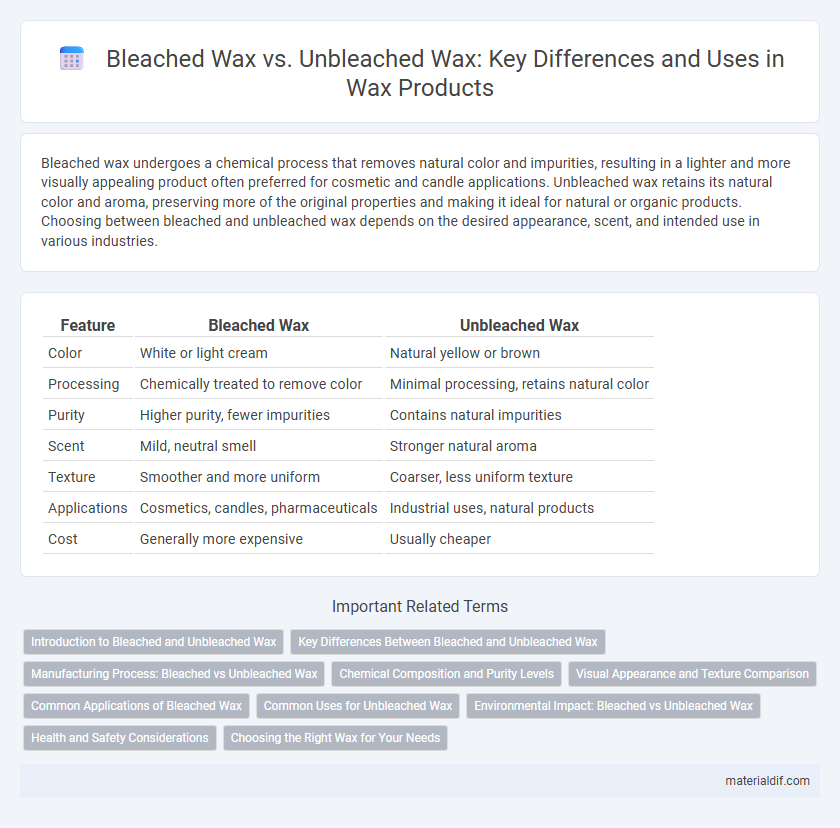Bleached wax undergoes a chemical process that removes natural color and impurities, resulting in a lighter and more visually appealing product often preferred for cosmetic and candle applications. Unbleached wax retains its natural color and aroma, preserving more of the original properties and making it ideal for natural or organic products. Choosing between bleached and unbleached wax depends on the desired appearance, scent, and intended use in various industries.
Table of Comparison
| Feature | Bleached Wax | Unbleached Wax |
|---|---|---|
| Color | White or light cream | Natural yellow or brown |
| Processing | Chemically treated to remove color | Minimal processing, retains natural color |
| Purity | Higher purity, fewer impurities | Contains natural impurities |
| Scent | Mild, neutral smell | Stronger natural aroma |
| Texture | Smoother and more uniform | Coarser, less uniform texture |
| Applications | Cosmetics, candles, pharmaceuticals | Industrial uses, natural products |
| Cost | Generally more expensive | Usually cheaper |
Introduction to Bleached and Unbleached Wax
Bleached wax is treated with chemicals or exposed to light to remove impurities and lighten its color, making it ideal for applications requiring a clean, white appearance, such as cosmetics and food packaging. Unbleached wax retains its natural color and components, providing a more raw, organic option preferred in artisanal candle making and natural skincare products. Both types maintain similar physical properties like melting point and texture but differ primarily in appearance and purity levels, influencing their suitability for specific uses.
Key Differences Between Bleached and Unbleached Wax
Bleached wax undergoes a chemical process to remove its natural color, resulting in a lighter, more uniform appearance ideal for cosmetics and candle-making where aesthetics matter. Unbleached wax retains its natural yellow or brown hue, preserving more of the original nutrients and natural properties suitable for skincare and therapeutic uses. The choice between bleached and unbleached wax depends on application requirements, with bleached wax offering purity and consistency, while unbleached wax provides richer natural compounds and minimal processing.
Manufacturing Process: Bleached vs Unbleached Wax
Bleached wax undergoes a chemical bleaching process involving exposure to light, heat, or chemicals such as hydrogen peroxide or sulfur dioxide to remove impurities and color. Unbleached wax retains its natural color and contains more natural residues since it skips the bleaching step. The bleaching process can also alter the wax's texture and melting point, making bleached wax smoother and more consistent for certain applications.
Chemical Composition and Purity Levels
Bleached wax undergoes chemical treatments that strip away natural color and impurities, resulting in higher purity levels but potentially altering the original chemical composition by reducing natural hydrocarbons and wax esters. Unbleached wax retains its natural color and chemical constituents, including long-chain hydrocarbons, fatty acids, and alcohols, offering a composition closer to its raw state with moderate purity. The choice between bleached and unbleached wax depends on the desired balance between purity and chemical integrity for applications such as cosmetics, food coatings, or industrial uses.
Visual Appearance and Texture Comparison
Bleached wax exhibits a uniform, bright white appearance due to chemical processing that removes natural pigments, enhancing its visual appeal for decorative and cosmetic applications. Unbleached wax retains its natural yellow or amber hue, offering a rustic, organic look preferred in artisanal candles and skincare products. Texture differences include bleached wax being smoother and more refined, while unbleached wax often presents a slightly coarser, grainier surface, impacting melt behavior and fragrance retention.
Common Applications of Bleached Wax
Bleached wax is primarily used in cosmetics, pharmaceuticals, and food products due to its pure, white appearance and consistent texture, enhancing the aesthetic and safety standards required in these industries. It is commonly found in lip balms, skincare formulations, and confectionery coatings where visual appeal and non-toxicity are crucial. The bleaching process removes impurities and color from the wax, making it ideal for applications requiring a clean, neutral finish.
Common Uses for Unbleached Wax
Unbleached wax is widely used in natural skincare products and organic candles due to its retained nutrients and minimal processing. Its rich yellow or golden color makes it popular for lip balms, salves, and lotions where natural aesthetics and purity are prioritized. This type of wax is favored for eco-friendly packaging and food wraps, providing a sustainable alternative to synthetic coatings.
Environmental Impact: Bleached vs Unbleached Wax
Bleached wax undergoes chemical processing that often involves chlorine or peroxide, leading to potential release of harmful byproducts and increased environmental pollution. Unbleached wax retains its natural properties, minimizing chemical usage and reducing ecological footprint by limiting industrial waste and energy consumption. Choosing unbleached wax supports sustainable production practices and preserves soil and water quality more effectively than bleached alternatives.
Health and Safety Considerations
Unbleached wax retains natural compounds and fewer chemical residues, reducing the risk of skin irritation and respiratory issues compared to bleached wax, which undergoes chemical treatments that may leave trace contaminants. Health-conscious users prefer unbleached wax for its minimal processing, ensuring safer application, especially for sensitive skin or allergies. Proper storage and handling further mitigate potential exposure to harmful substances, maintaining overall safety during use.
Choosing the Right Wax for Your Needs
Bleached wax offers a cleaner, more neutral appearance ideal for cosmetic and candle-making applications requiring a pure look, while unbleached wax retains natural color and scent, preferred for organic or rustic products. Selecting the right wax depends on the desired aesthetic, fragrance intensity, and specific usage, with bleached wax providing a refined finish and unbleached wax maintaining natural properties. Consider product formulation and target customer preferences to determine whether bleached or unbleached wax best suits your needs.
Bleached Wax vs Unbleached Wax Infographic

 materialdif.com
materialdif.com